In-depth review When Rolex was the king of ‘Sports Elegance’ – Part 2
Fine WatchesCollector's InsightA focus on Enamel Dials
A while back I wrote an article on the 50 goals of a watch collector should have. One of them is owning a watch with Enamel dial.
Some of the most collectable and valuable watches are Enamel dials made by either Rolex or Patek Philippe. Think double crown world-time for Patek like 2523. Or within Rolex the Peacocks, Dragons, Neptune’s, or my favourite – the dial of the Americas, found on Ref 6100, 6101 or Ref 6085 by Rolex. Indeed, these are exceptionally fine watches with dials, often made by the master enameller Carlo (Charles) Poluzzi or Marguerite Koch. I will devote a separate post to these watches in the future. However, for this article, I intend to focus on another set of enamel dials by Rolex.
Those of ‘uni-colour’ dials.
(Cover picture Credit: Goldberger wearing his blue 6090 Enamel).
For me the’ uni-colour’ dials are the most beautiful Enamel dials Rolex made. Why?
Because the color itself becomes the centre point of the dial (instead of a motif). The known colors for the Enamel dials are tobacco brown, blue and, my favourite color, green. Contrary to some reports that were recently written, Rolex never made black Enamel dials in my opinion (instead they are black lacquer). Enamel dials are most often found in reference 6085, 6090, 6100, 6101, 6102, 6285, 6290 and last 6301. The maker of most, if not all, these single color enamel dials was the Stern Freres company. It is unsure if Charles Poluzzi was also involved (some catalogues mention his name in association with these single or uni- coloured dials).
Again like in the last post, I am only focussing on gold cased Rolex watches (beside the fact that Enamel dials are found only on very few steel watches).
Let us start with one of the most beautiful ones, a 1951 Rolex ref 6085, in pink gold with green Enamel dial.
Out of the all the uni-colour Enamel dials ever made, this watch must rank as one of the most attractive. This is for a variety of reasons. 1) it is made in pink gold which is among the rarest Rolex Enamel dials made. 2) its s offered with the elusive green dial. 3) Engine turned bezel gives it that masculine and attractive look.
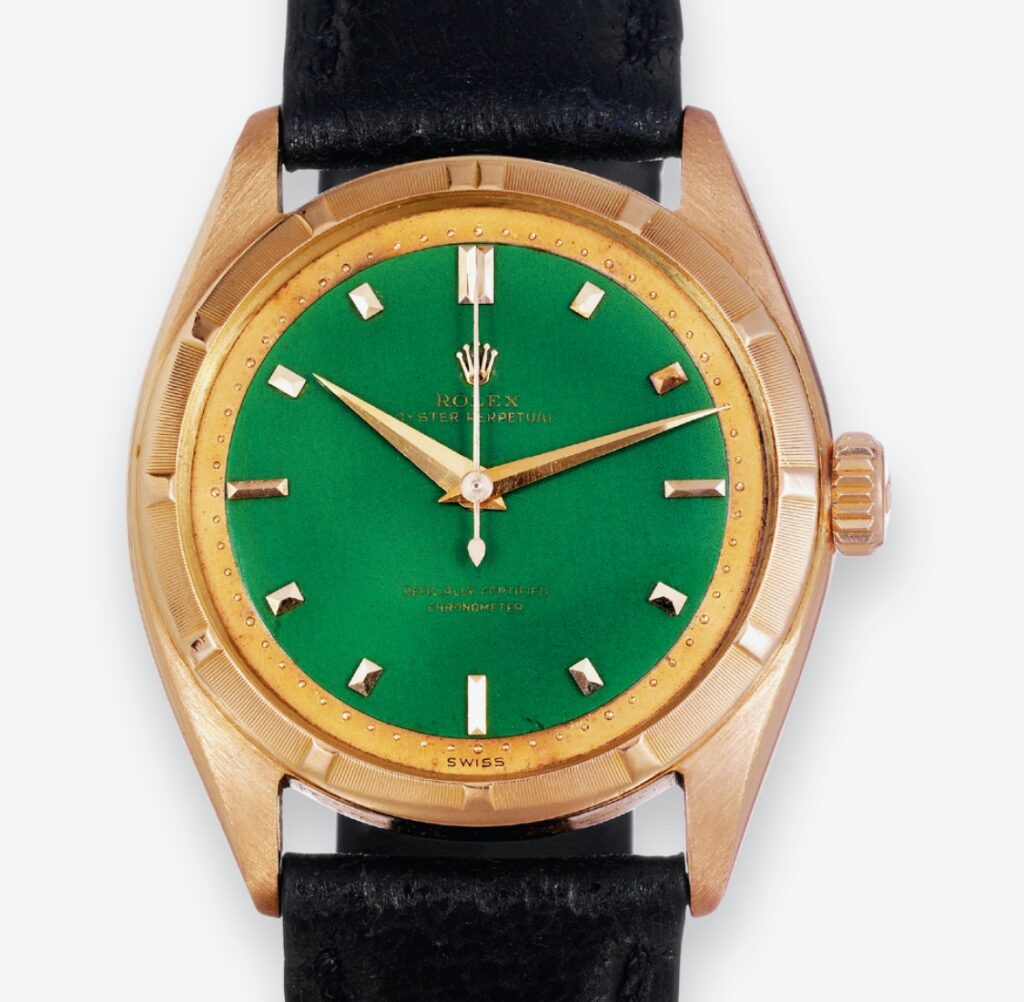
(Credit: Antiquorum).
This watch sold at Antiquorum in 2009 for CHF 43’000. Serial Nr is unknown and not stated in the catalogue. Notice the mention of the Code Number in the lot notes of Antiquorum. 103*591. This the stern code for Rolex (103), the star for the dial maker Stern Freres.
Another example of an Enamel Rolex, this time it is a cloisonné, but the principle remains the same. Once again the Rolex code for the dial maker (Stern Freres) then the star for Stern and last number is the order number.
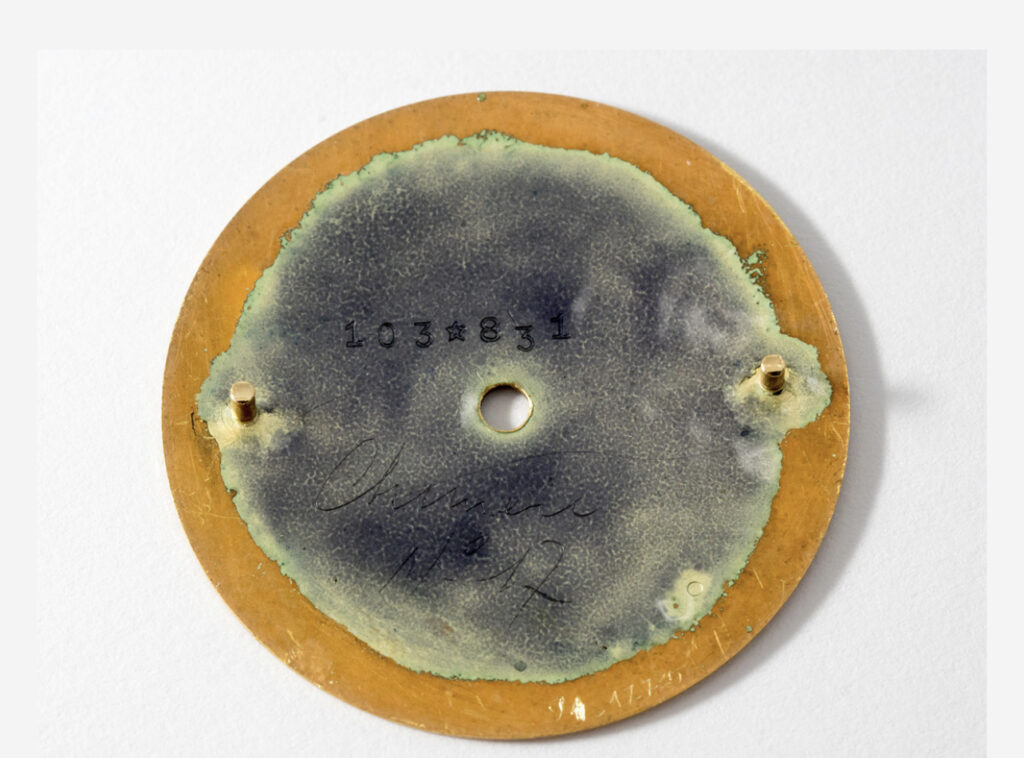
(Credit: Phillipswatches).
Below I found another green Enamel dial in this 1951 Rolex ref 6085 with an incredible hexagonal links bracelet. This watch also sold at Antiquorum in 2005 for a nice CHF 36’800. Serial Nr is unknown. Without a doubt also one the most attractive Enamel watches ever offered for sale, (judging from the picture alone).
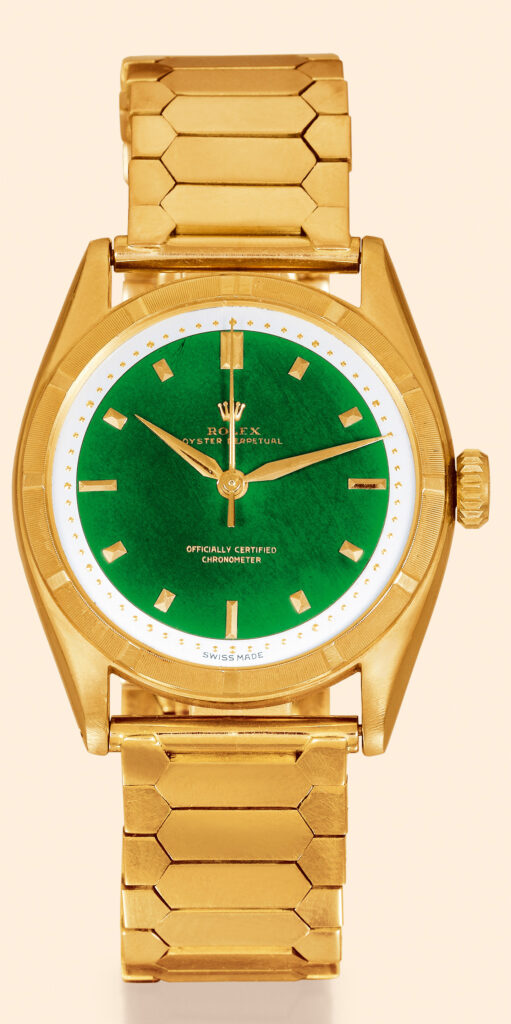
(Credit: Antiquorum).
The next one is a ref 6100 and was sold at the famous Mondani auction back in 2006.
Notice the absence of the engine turned bezel (but rather a smooth bezel). I personally far prefer the engine turned bezel of the watch above. They just add character and artistic flair that better fits with these time only masterpieces. Serial Nr 902 5xx.
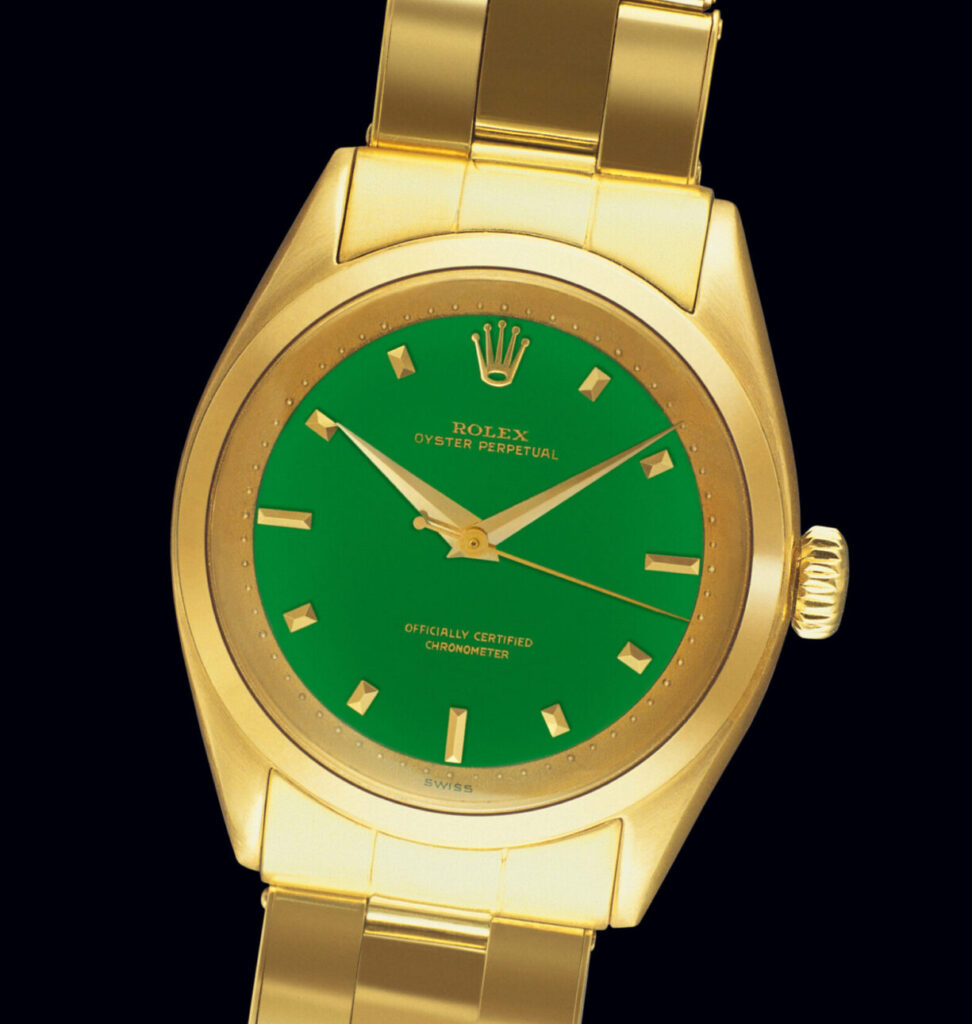
Credit: Antiquorum).
The last green Enamel dial I show is from a more recent 2014 auction that took place in NY.
A small unknown auction house, called Doyle auctions in NY, auctioned off this beautiful early 1950s Rolex ref 6101 with green Enamel dial for $59’000 after having an estimate of only $4-6’000. It had a Serial Nr 746 2xx. The fact that this watch in an un-known auction house managed to fetch 15x the low and estimate and almost 10x the high estimate – just shows how collectable these rare Rolex watches are.
The watch below is attractive for a variety of reasons. 1) it has the engined turned bezel. 2) it has an early cut-off crown pointing to a very early dial. 3) Dial and case seem to be in strong condition.
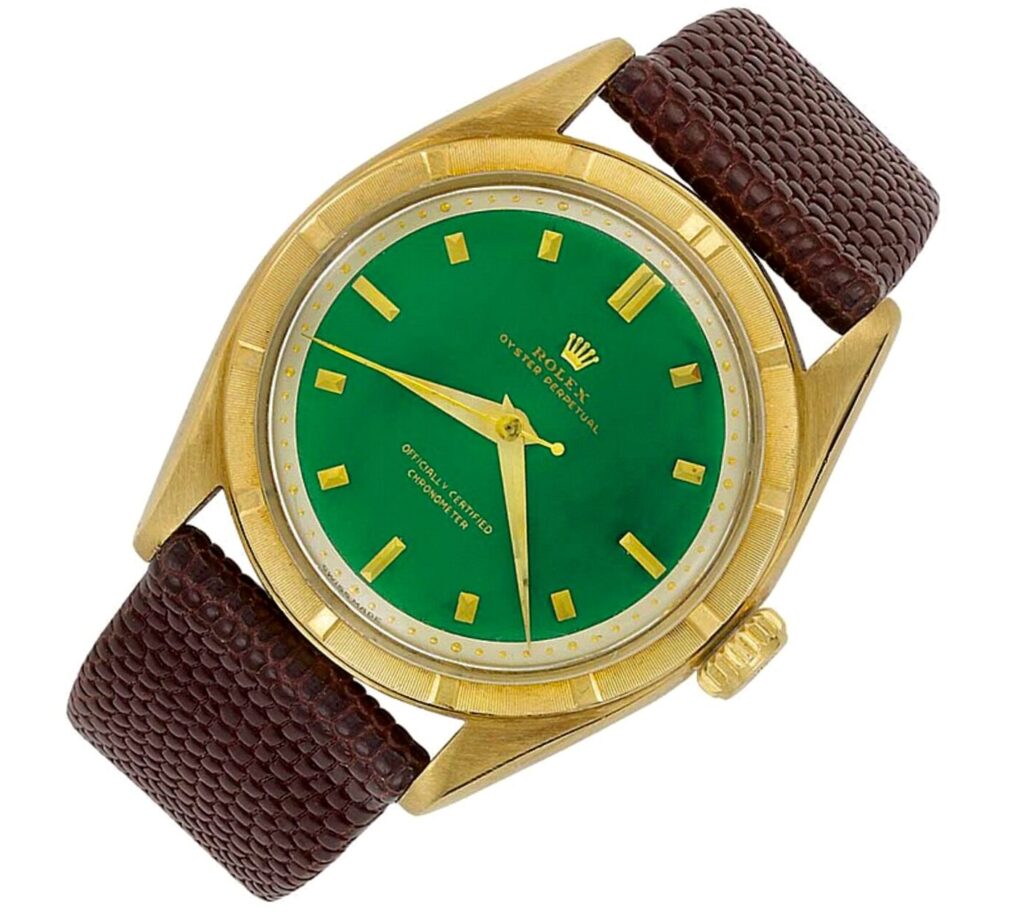
(Credit: Doyle auction house).
Green enamel dials are rare and beautiful.
Besides these 5 watches, I have not been able to find another Green Enamel dial Rolex with automatic movement in all of auction history over the past twenty years.
Also interesting to note is that many green Enamel dials were made across various reference numbers within a narrow range. So a 6085 and 6101 could have a almost the same serial number even if the reference or model of the watch was different. It is my dream one day to own a green Enamel dial Rolex.
Also, very high up on the scale of rarity, is the tobacco brown enamel dial.
In fact, I have been only able to find three of them. The first is the one below with a so called ‘cut off’ Rolex crown. It is a 6101 Rolex, that was sold at Sotheby’s in 2012 for CHF 28’000. It now sits in one of the greatest watch collections in the world. Like the green one, it is made by Stern Freres for Rolex. What is interesting is the very close serial number for both the brown dial below and the green dial above, even if both have different reference numbers.
Below like the green above Serial Nr 746 2xx.
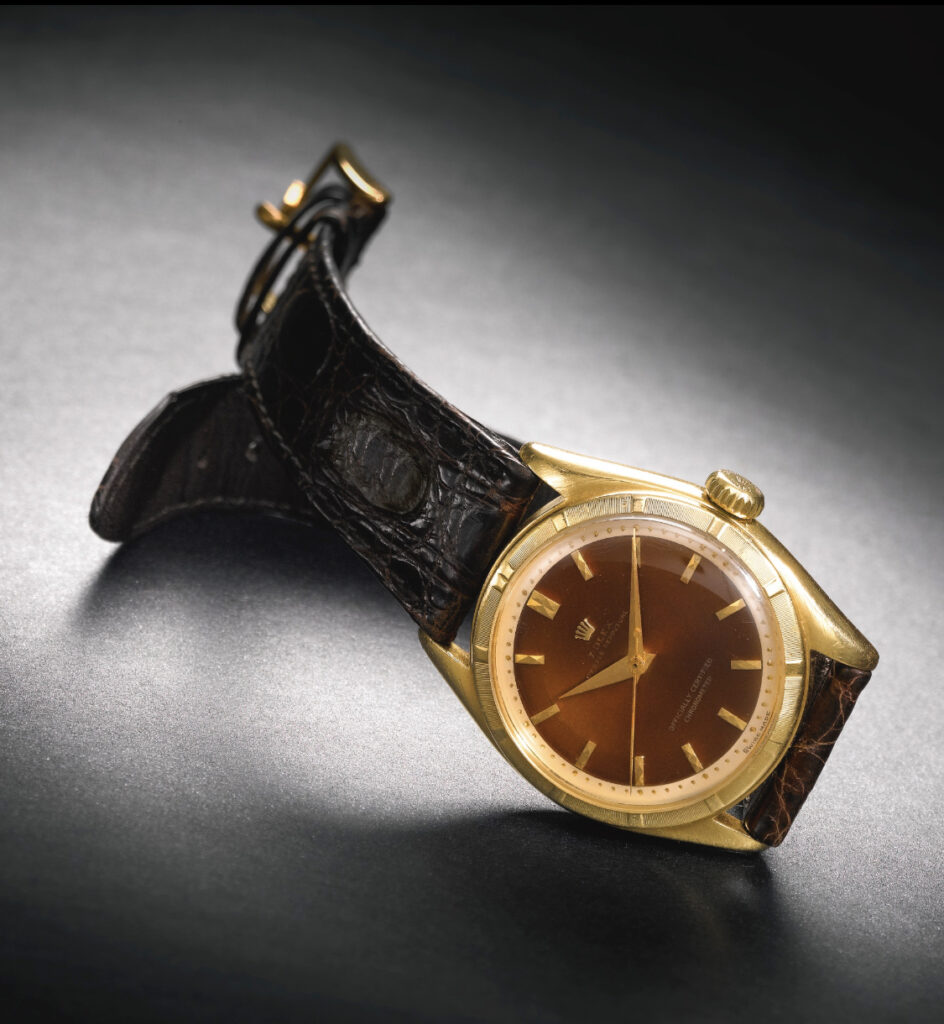
(Credit: Goldberger).
The second one is what I believe is a 6100/6101 that was sold at Antiquorum in 2005 for CHF 9’000.
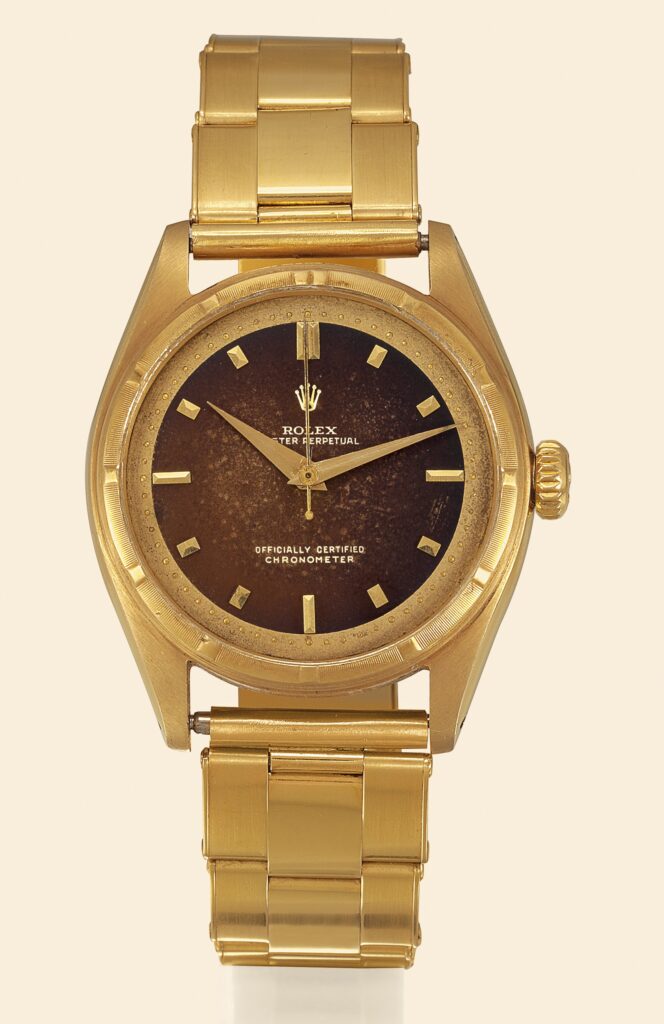
(Credit: Antiquorum).
The last one is a 1953 Rolex ref 6018 that can be found in the 100 Rolex book /app from John Goldberger. Notice the Bombay or Bombe style case often found in Ref 6090.
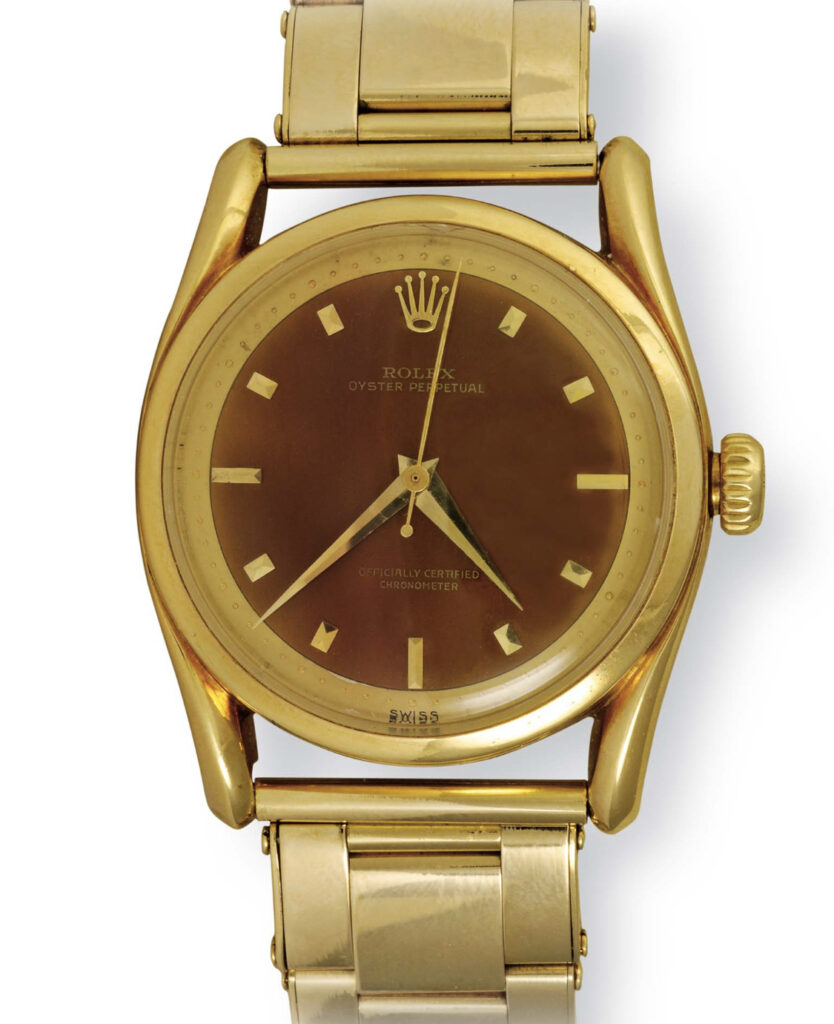
(Credit: Goldberger).
We move on to the last fantastic color, (even if it seems to be the most common of them), blue.
Blue enamel existed across a variety of Rolex references that all carried automatic movements, 6085, 6090, 6100, 6101, 6102 and 6290.
The earliest documented blue Enamel dial, for which I have a price, is this gorgeous example. A 1951 Rolex Ref 6085 sold in May 2002 for a super strong USD 26’300. This result is incredible for many reasons. First, it shows that already back then demand was very large for Enamel dials in Rolex watches. Secondly, consider that a mint 6239 Paul Newman Daytona sold for USD 25’000 in the same sale. Yes, we now know what the better investment would have been, however I think things might reverse from here (more on this in my closing thoughts towards the end).
Below the superb example, that carried a case Nr 819′ 7xx. Notice the strong case and engined turned bezel. For me it is the best blue dial Enamel Rolex to ever appear on the market.
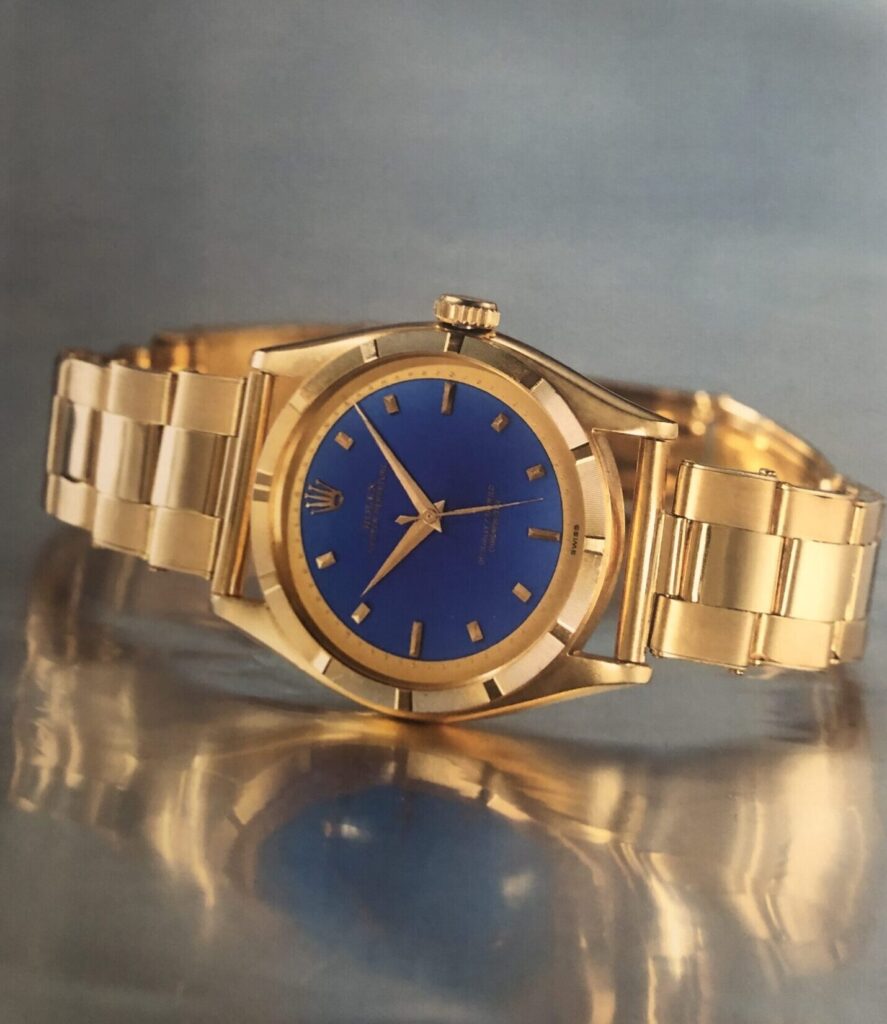
(Credit: Phillips de & Luxembourg Catalogue May 2002).
What is most interesting is the description of the watch in the catalogue.
Notice the descriptive text: ‘At the height of their artistic inspiration at the beginning of the 1960s, Rolex competed for clients in a niche market traditionally held by Patek & Vacheron.’ Exactly what I have been arguing in Part 1 already.
Furthermore there is speculation that the dials came from Poluzzi who would do work for various companies (Rolex, Vacheron and Patek among the notable names).
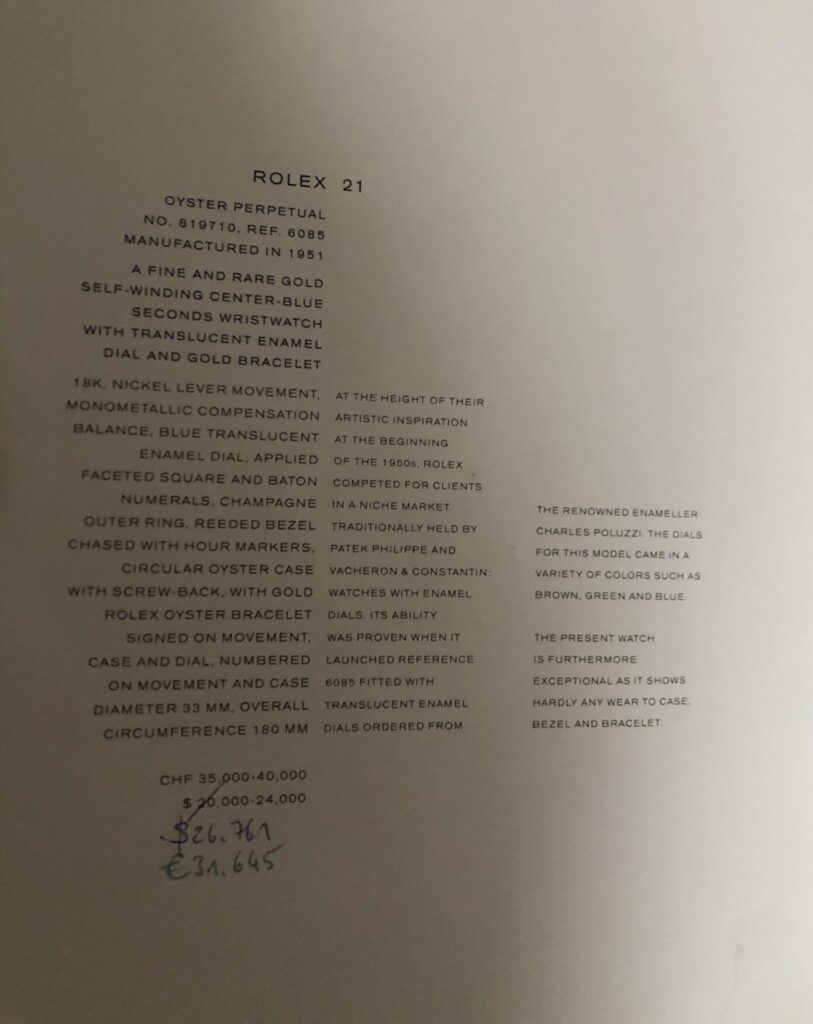
(Credit: Phillips de & Luxembourg Catalogue May 2002).
Some seven years later, another Rolex 6085 sold at Antiquorum for slightly more money (it could well be the same as the above- given their rarity); a 1951 Rolex with blue dial sold at Antiquorum in 2009 for CHF 37’000 back in 2009. See the watch below. Serial Nr unknown.
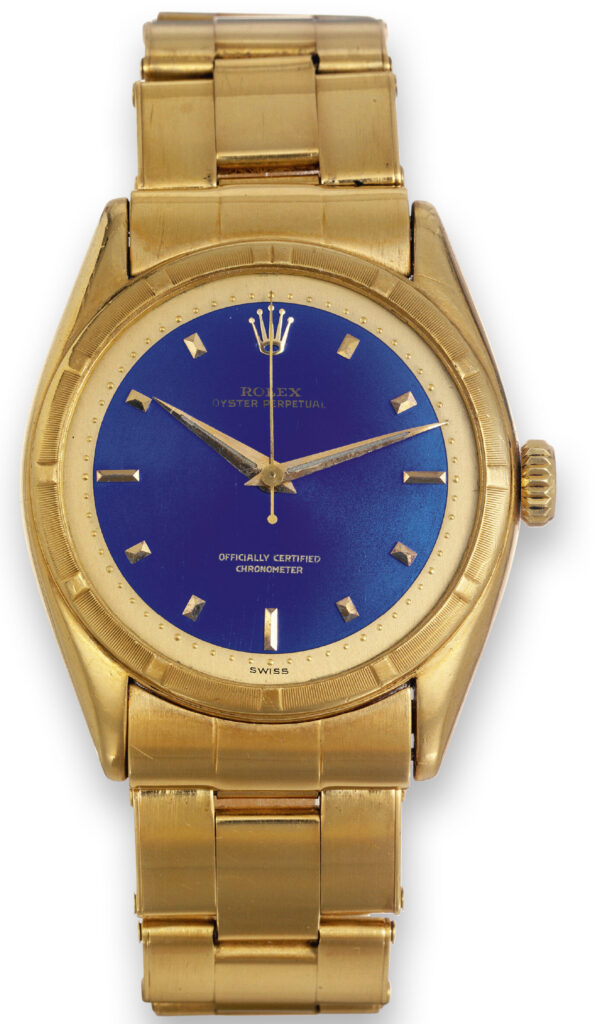
(Credit: Antiquorum).
According to the Antiquorum lot notes the dial is signed from the back with code 103*3106.
Again these numbers are the Stern Freres codes for Rolex: 103 denoting the Rolex code for Stern and the * denoting Stern Freres.
A blue Enamel watch is also found in Ref 6100 by Rolex. Observe the smooth bezel (versus the engine turned bezel above). I prefer the look of the watch above.
Nonetheless, this watch belonged to the Mondani collection and was auctioned in 2006 for CHF 43’600. The watch now resides with the well known international dealer Davide Parmegiani. Notice the absence of the Rolex writing and ‘OCC ‘ on the dial below. Serial Nr 902′ 5xx.
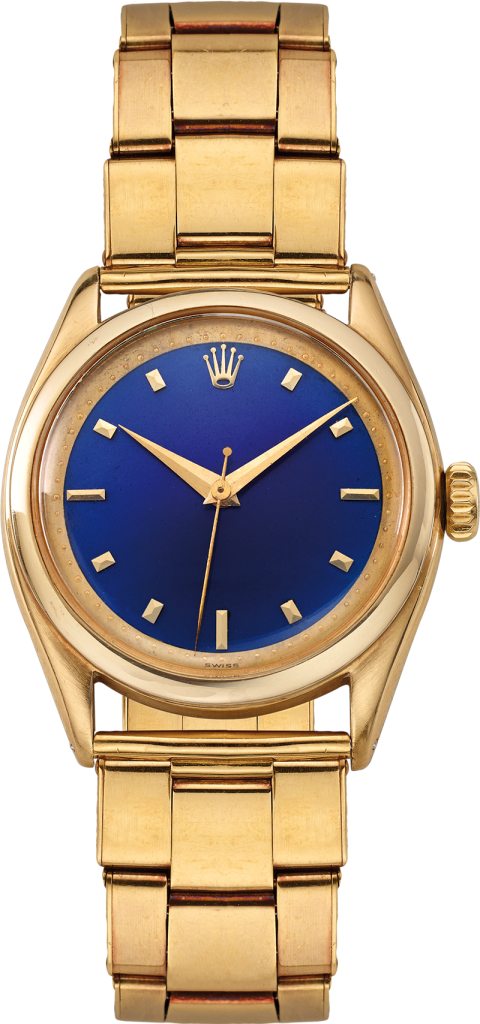
(Credit: Davide Parmegiani).
The next blue dial I show is from this very rare early 1953 Rolex Ref 6285 that sold also at Mondani auction back in 2006.
It is exactly the same as the watch above, except it carries a Ref 6285 instead of 6085 and has a engined turned bezel (instead of smooth bezel above). Perhaps the condition (and rarity) explains why it fetched slightly more than the watch above with a sale price of CHF 54’280. Serial Nr 963 3xx.
Other small differences between both watches include the ‘cut off’ crown below (versus full crown above).
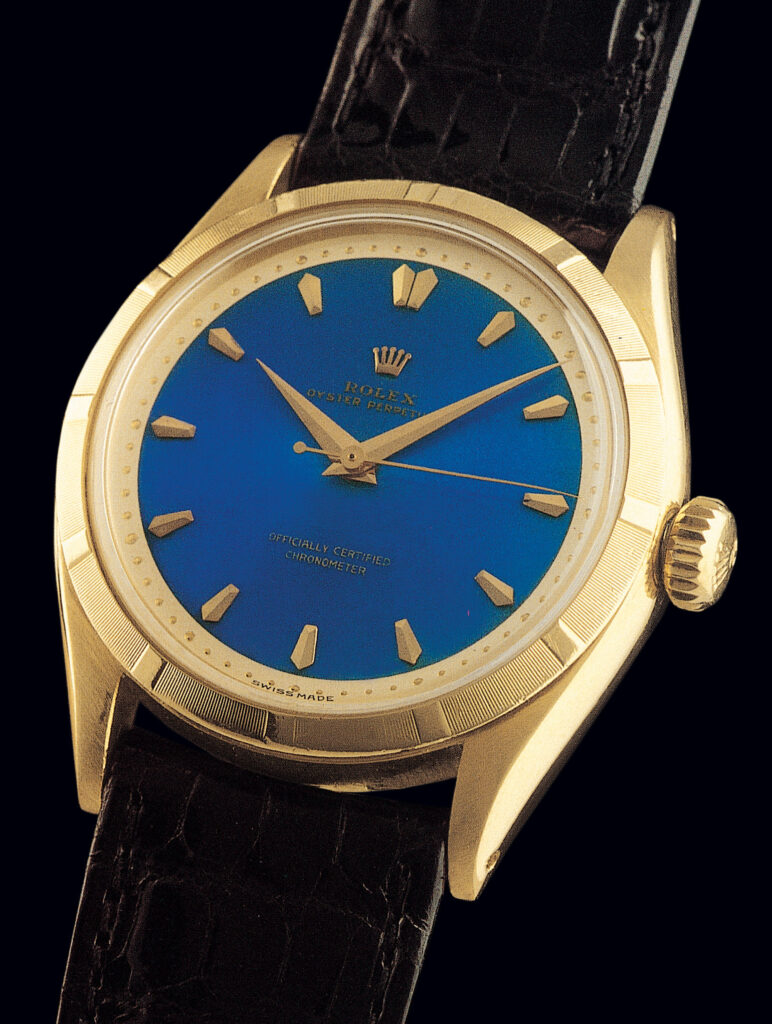
Blue Enamel dials were also found in other cases by Rolex that were not the typical oyster cases. Earlier this year in 2020 Phillips auctioned off a blue Enamel dial, a 1951 Rolex 6090 (Bombay model or bombe) which was very attractive.
There was strong interest and the watch ended up selling for CHF 93’000 towards the high estimate of CHF 100k. See the picture below I took of the watch in natural sunlight at the Phillips watches preview in Geneva. Serial Nr 730’2xx.
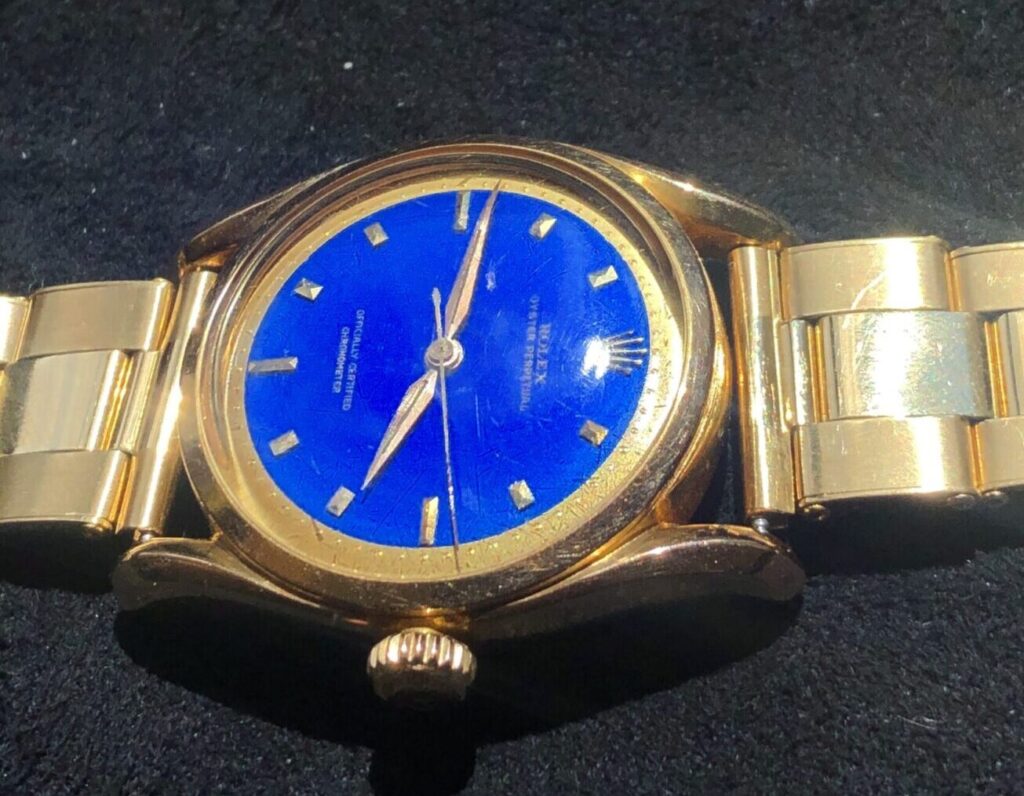
What to look out for with all Enamel dials concerning their originality, is the back of the dial.
Often a code from Stern Freres was engraved on the back, like with the watch above from Phillips watches. See picture below. The 106 number being most probably the last numbers before 103 * (similar to one of the watches earlier above).
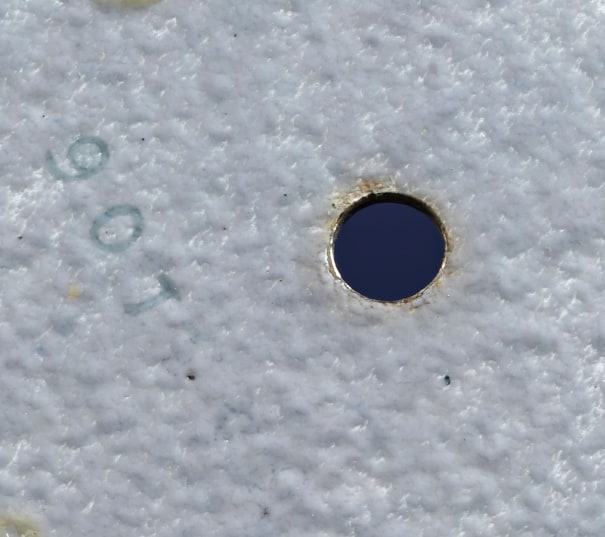
(Credit: Phillips watches).
This is how a blue enamel dial that belongs in a Ref 6290 Rolex Bombe case, looks like when it is removed.

(Credit: Sothebys /Charlie Foxhall).
Indeed the watch above is from a recent sale at Sotheby’s where the 6290 Rolex fetched CHF 81k. Serial Nr 975’5xx.

(Credit: Sotheby’s).
The back of the dial on the Sotheby’s watch shows the codes you want to see. 103* – with 103 being the order number for Rolex and the star for Stern Freres dial maker.
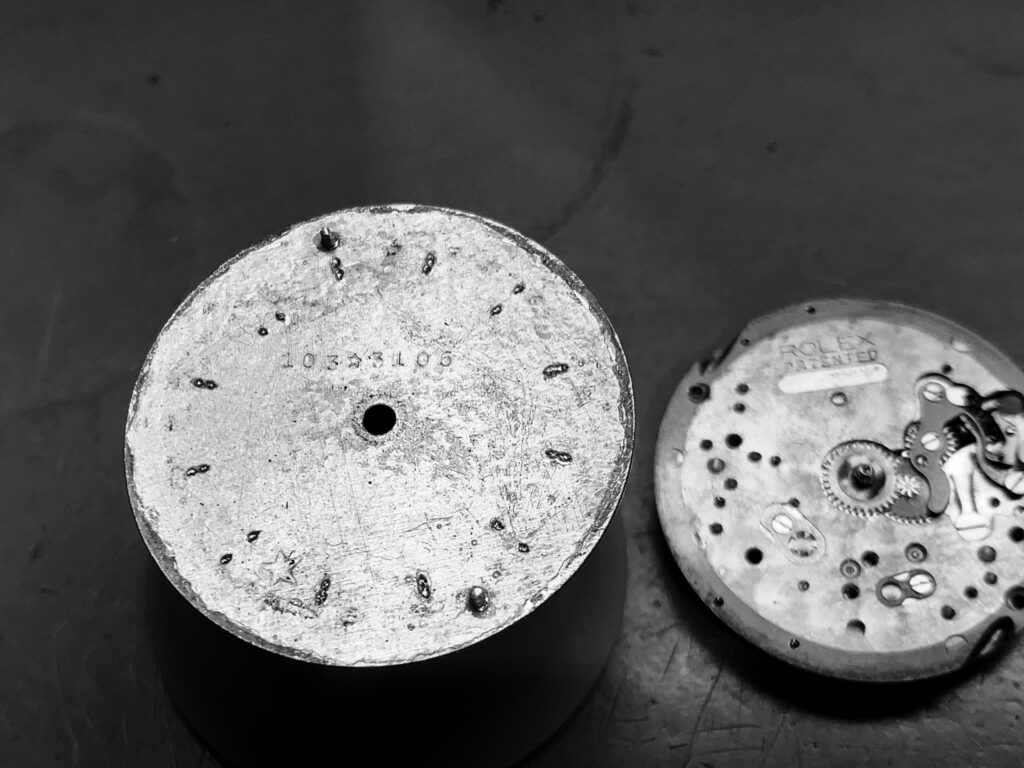
(Credit: Jim Gerber).
The last blue Enamel I show is 6102 that also belongs to the ‘Bombe’ group of family watches (like the 6290).
One was sold at Antiquorum for more than USD 60’000 already back in 2011 (serial number unknown). See the beautiful color of the Antiquorum watch below.
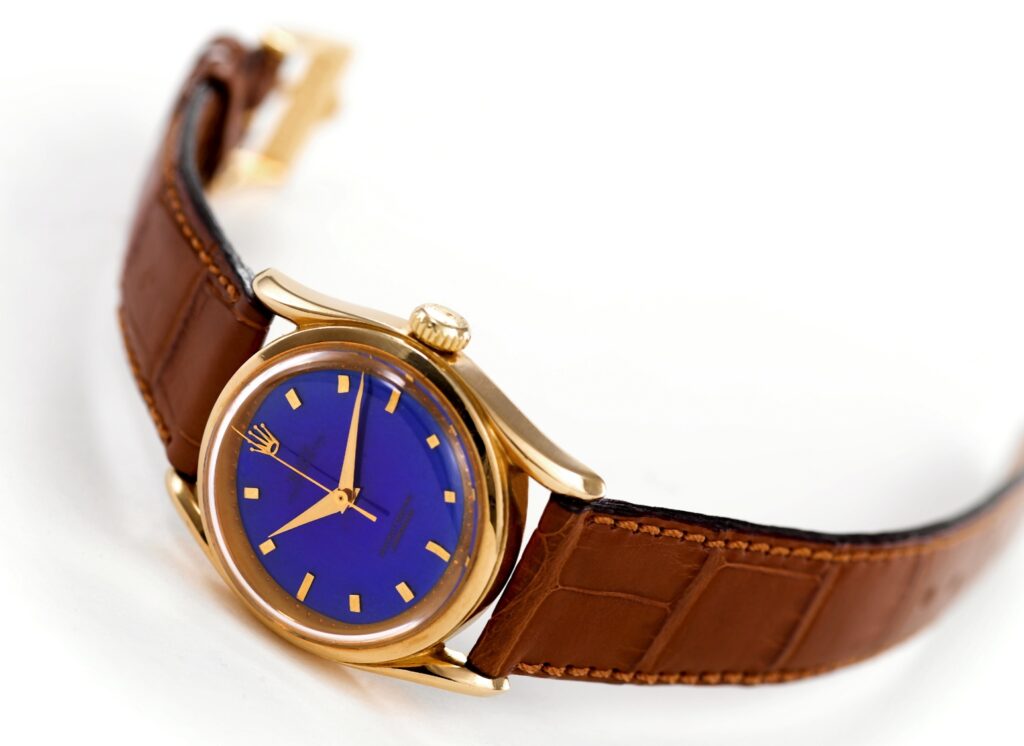
But I would like to focus on a more recent sale back in 2015 at Phillips.
It is unclear if it is the same watch, but at this sale another 6102 that fetched an incredible CHF 180’000 far exceeding the estimate of CHF 50-80’000. The serial number fits perfectly in the expected range of other Enamel dial watches and is the third serial number to have 902’5xx.
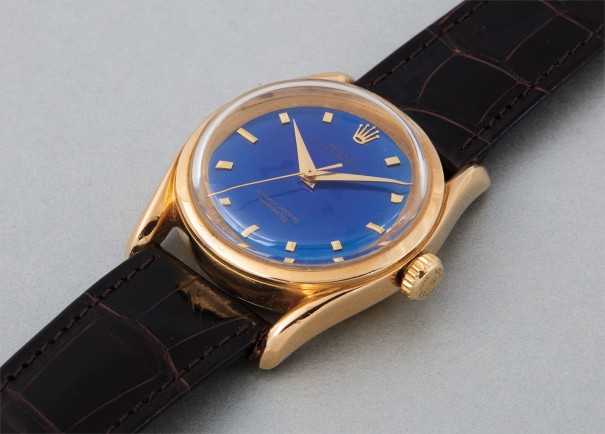
(Credit: Phillipswatches).
Below the catalogue description and notes of the watch when it was sold in 2015.
Notice the back of the dial with some numbers written on it (hard to identify the exact numbers though). Again, I cannot repeat this enough: It is important that collectors always look at the back of the dial before buying Enamel watches.
Faintly seen on the back the dial for the Phillips watch 103*.
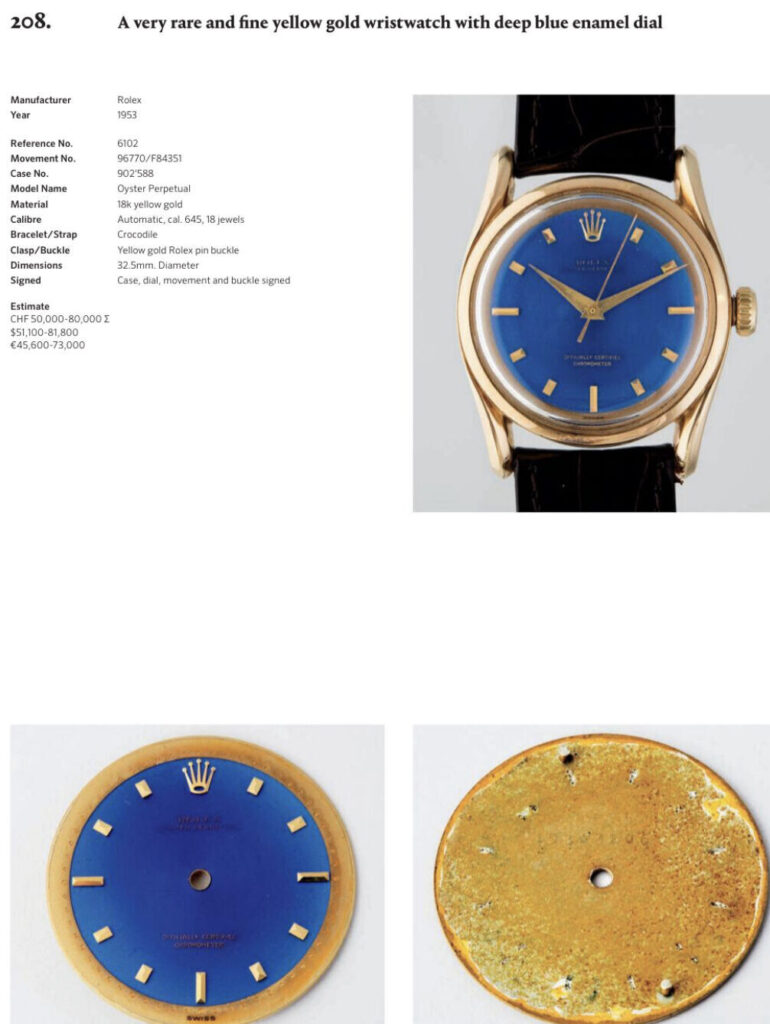
A quick comment regarding the signature found at the bottom of uni-colour enamel dials.
I am not sure if you noticed, but the dials have various signatures, all of which seem to be correct: Swiss, Swiss Made, and no signature at all. I have no reason to be believe that one of them might be wrong, and the real test of course, is to make sure that the dials have the proper codes on the back. Below two of the most uncommon dials, ‘Swiss Made’ and no signature below. The most common seems to be ‘Swiss’.
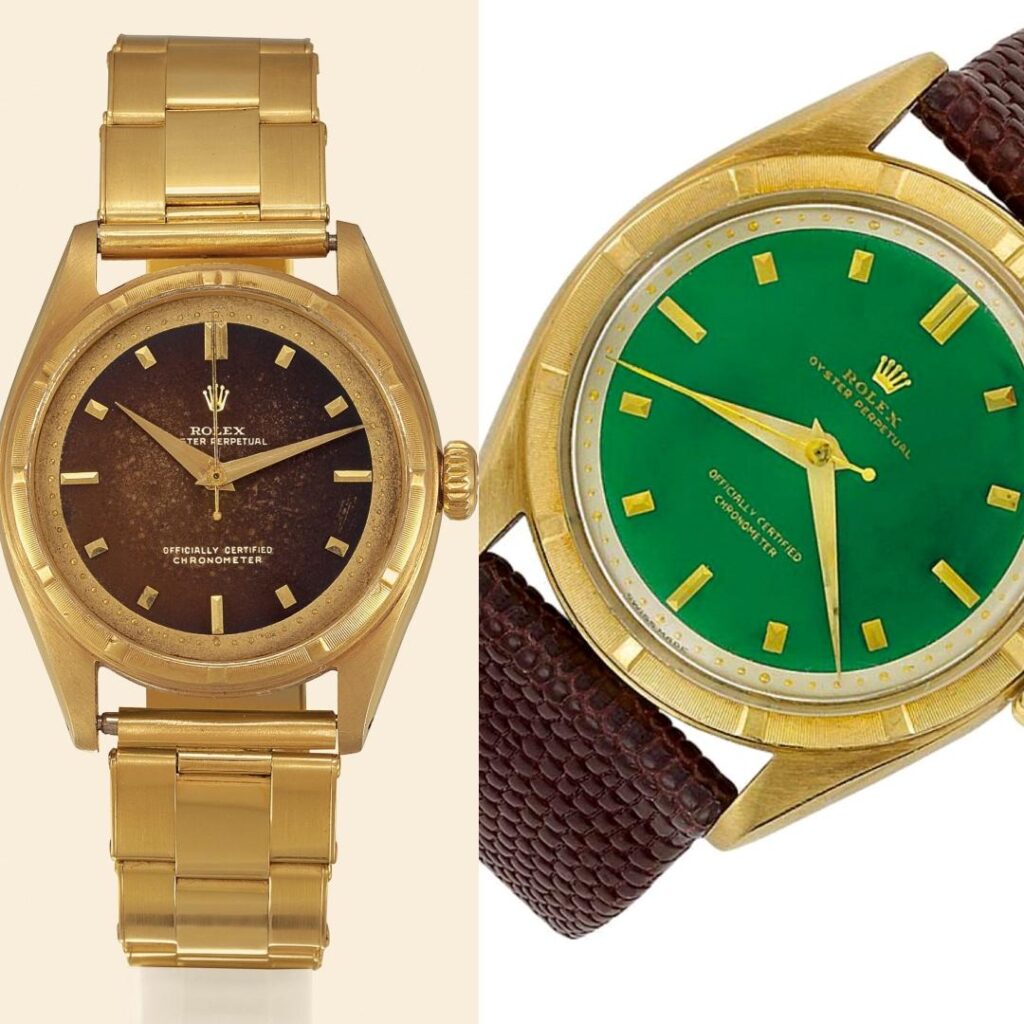
(Credit: Antiquorum / Doyles Auction House).
Before I conclude, one last point on the serial numbers found on Enamel uni-colour dials.
Because these watches were made in a very short period of time (all in early 1950’s; most 1951-52), the serial numbers are found in a narrow range. They range from 730’2xx to 975’5xx. Interesting to note the earliest and last publicly sold Enamel dials are both Bombe cases 6090 and 6290 and both have blue dials. Below a summary of serial Numbers and dial color. Obviously some information is missing as many watches that were sold at Antiquorum in the 2009/10 timeframe don’t mention the serial number.
Also important to note-I assume that Enamel dials were partially made in batches. That is because we have many watches made very close to each other. See the serial info below of all the watches in this report. Three of the serial numbers are extremely close to each other – all carrying 902’5xx. The last watch on this list I included is privately held and interesting Ref 6301 with beautiful green dial.
- 730’2xx (Ref 6090, Blue dial)
- 746’2xx (Ref 6101, Green dial)
- 746’2xx (Ref 6101, Brown dial)
- 819’7xx (Ref 6085, Blue dial)
- 902’5xx (Ref 6100, Green dial)
- 902’5xx (Ref 6100, Blue dial)
- 902’5xx (Ref 6102, Blue dial)
- 963’3xx (Ref 6285, Blue dial)
- 975’5xx (Ref 6290, Blue dial
- 975’7xx (Ref 6301, Green dial)
Furthermore there are 3 uni-colour Enamel watches in the Goldberger book that fit in the serial range above. They are from lowest to highest:
- 746’2xx (Ref 6106, Green dial)
- 769’4xx (Ref 6085, Green dial)
- 763’770 (Ref 6285, Blue dial)
Concluding thoughts on Enamel dials
What is pretty clear is that Enamel dials by Rolex will always be sought-after by collectors. They are just super rare and beautiful.
Over the last 20 years, the demand and market of Rolex watches shifted somewhat to sports models that have a strong aesthetic appeal. Today the market for Rolex watches is also driven also by wearability, trends towards more casual and informal dressing. But if you go back twenty years the market was slightly different.
Twenty years ago, collectors in vintage watches placed a large weighting on rarity, craftsmanship, and complication. That is why these uni-color Enamel dial watches were so sought after and continue to be today. Nonetheless compared to mass produced steel sports watches – I believe these Enamel watches are completely undervalued.
Will we return to a market where the connoisseur values uni-color Enamel dials above sports models, at least from a price point of view?
I think as the market matures and becomes more sophisticated, there is a good chance that this might happen. After all, most collectors want to own something special, something unique that not everyone has. Also not much is published on Enamel dials and this post is a start to change that.
I truly believe that ‘uni-color‘ Enamel dials by Rolex are trophy watches for collectors for the sheer rarity and beauty. That they are priced today below many sports-models is due to a current trend or fad.
And over long periods of time, trends tend to fade and then end.
NB: For Part 1 with Explorer dials please see our story here. For part 3 on Enamel dials here. For full disclosure purposes I have, or might have, a personal interest in one of the watches above in terms of ownership.
